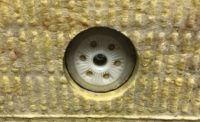Optimizing Thermal and Air Barriers for Mineral Wool Attachment
Attachment suggestions for thermal and air barrier performance.



Retaining disc permanently holds mineral wool insulation on a mechanically attached impaling pin.











Mineral wool, stone wool, rock wool—an insulation with many names but at the core, it is comprised of melted rocks that are spun into fiber. If you ever get the opportunity to visit a mineral wool manufacturing facility, you’ll get to see the equivalent of liquid hot magma spun like cotton candy into an adaptable material used in everything from insulation, sound-deadening ceiling tiles, fire protection, and even heat shields for the aerospace industry.
Energy codes are calling for increased use of continuous insulation. Though there are many types of insulations that achieve a higher R-value per inch, including XPS and Polyiso, mineral wool is growing in popularity as a suitable layer of exterior continuous insulation due to its combination of thermal, acoustical, and fire protection performance.
Mineral wool panels used in exterior wall insulation typically range from 16 inch by 48 inch to 24 inch by 48 inch. These are small in size compared to common 48-inch by 96-inch panels of extruded rigid foam insulation. Smaller sized panels are primarily due to the fragile nature of mineral wool. The fibrous composition of mineral wool requires builders and building designers to stop and think about how it should be permanently secured within the building envelope. Furthermore, how can mineral wool be secured without creating additional thermal-bridges and penetrations of the air and weather barrier?
In addition to continuous insulation, ever-evolving energy codes are also calling for an increase in the use of air barrier performance of the entire building envelope. This is where the use of mineral wool can pose a particular challenge.
CI Installation
Rigid extruded continuous insulation is typically installed as a layer of exterior continuous insulation via mechanical attachment with a washer and screw. The rigid composition of extruded insulation compresses under the washer, creating a gasket effect that can effectively seal the fastener penetration on both the surface of the insulation, as well as at the air barrier penetration. Mineral wool insulation is fibrous and does not create the same gasketing effect as rigid extruded insulation, and therefore it is critical to consider a fastening method that will maintain air barrier performance.
A few attachment methods to consider:
Screws and washers: If you plan to use a traditional washer/screw to blindly attach mineral wool continuous insulation, an easy way to reduce the number of penetrations and thermal-bridging is to use a large 3-inch diameter plastic washer. The larger the washer diameter, the fewer fasteners required to achieve proper attachment. Furthermore, plastic washers conduct and radiate far less heat and energy than more commonly available metal washer plates (commonly a roofing insulation plate). Metal washers attached with metal screws into the steel studs of a commercial building act like mini radiators that transmit heat and energy easily through the insulation. If you must use screws/washers, be sure to use an exterior coated screw that can handle the elements for the lifespan of the building, and be sure to use a large diameter plastic washer to reduce thermal-bridging. And perhaps most importantly, be sure to hit the studs!
Impaling pins: An architect or building designer’s initial idea to combat blind fastener penetrations and thermal-bridging through fibrous blankets of insulation is to specify the humble impaling pin. HVAC heating ducts and air plenums are commonly insulated with readily available peel-and-stick or adhesive base stick pins. These may work great for insulating metal ductwork, but when used on the outside surface of an air-barrier system, you create the risk of damaging the very layer of the building envelope that controls air and moisture performance.
For the lifetime of the building, gravity will tug on the insulation and create forces on the impaling pin that may slowly rip and tear the air barrier. This can be a recipe for disaster. The solution is to combine the energy performance of an impaling pin with the long term strength of a mechanical fastener.
Purpose designed mechanically attached impaling pins include a plastic washer as a base that, #1 help seal the screw penetration against air and water, and #2 reduce thermal-bridging of the wall assembly. A typical 2-foot by 4-foot panel of mineral wool insulation will require 2-6 impaling pin fasteners, depending on the specific assembly. A minimal investment in a better fastening method will decrease thermal-bridging and air barrier penetrations for the lifespan of the building, and will result in fewer call-backs of the builder to fix issues created by sub-standard installation. Do it once, do it right.
Cladding: Several cladding attachment systems have been developed specifically for mineral wool insulation. Though all are different in their design and complexity, common features of proprietary rain screen cladding attachment systems include thermal efficiency and moisture drainage/ventilation. Mineral wool is often specified in open joint rain screens with cladding attachment systems due to its fire performance and air permeance. Sometimes the mineral wool insulation can be fully secured with these proprietary cladding attachment systems, but more often than not additional attachment of the mineral wool with a fastener or clip is required. A smart solution can be a stainless steel grip strap mechanically attached to the girts or rails of the cladding attachment system. This simple grip strap secures the insulation and does not penetrate the
air barrier.
With proper design considerations, mineral wool can be a great insulation solution within the building envelope. However, the devil can be in the details, so be sure to think about how you are going to achieve the following objectives:
- Maintain air barrier performance of the building envelope.
- Reduce the effects of thermal-bridging of the building envelope.
- Retain the insulation permanently in place for the lifespan of the building.
Looking for a reprint of this article?
From high-res PDFs to custom plaques, order your copy today!














